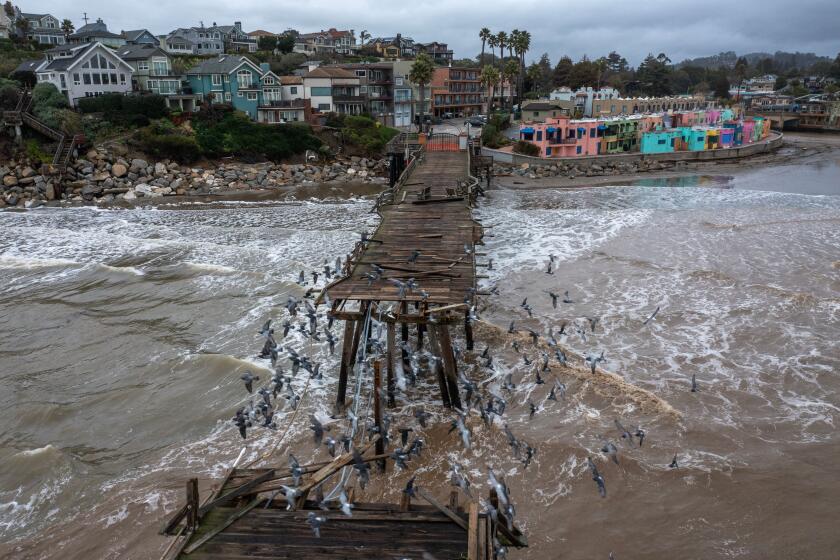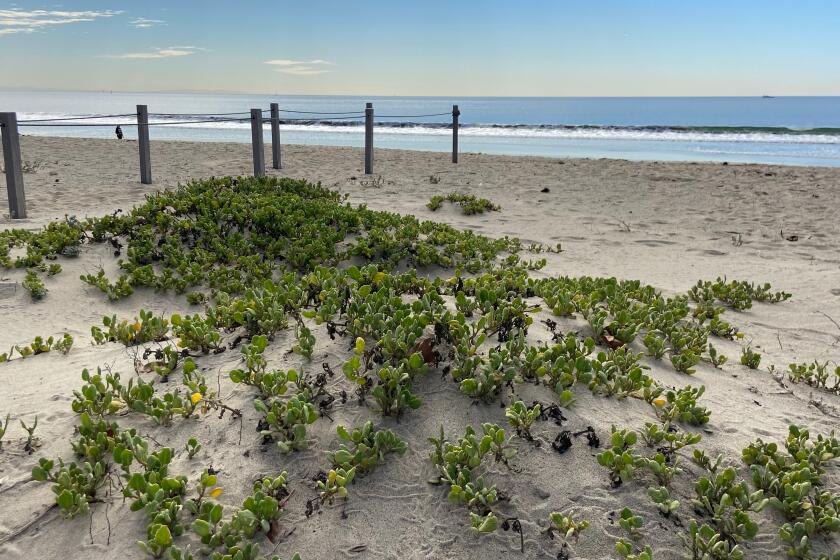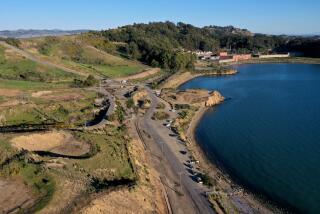A beach in Manhattan? Two years and $73 million later, sure (but no swimming allowed)
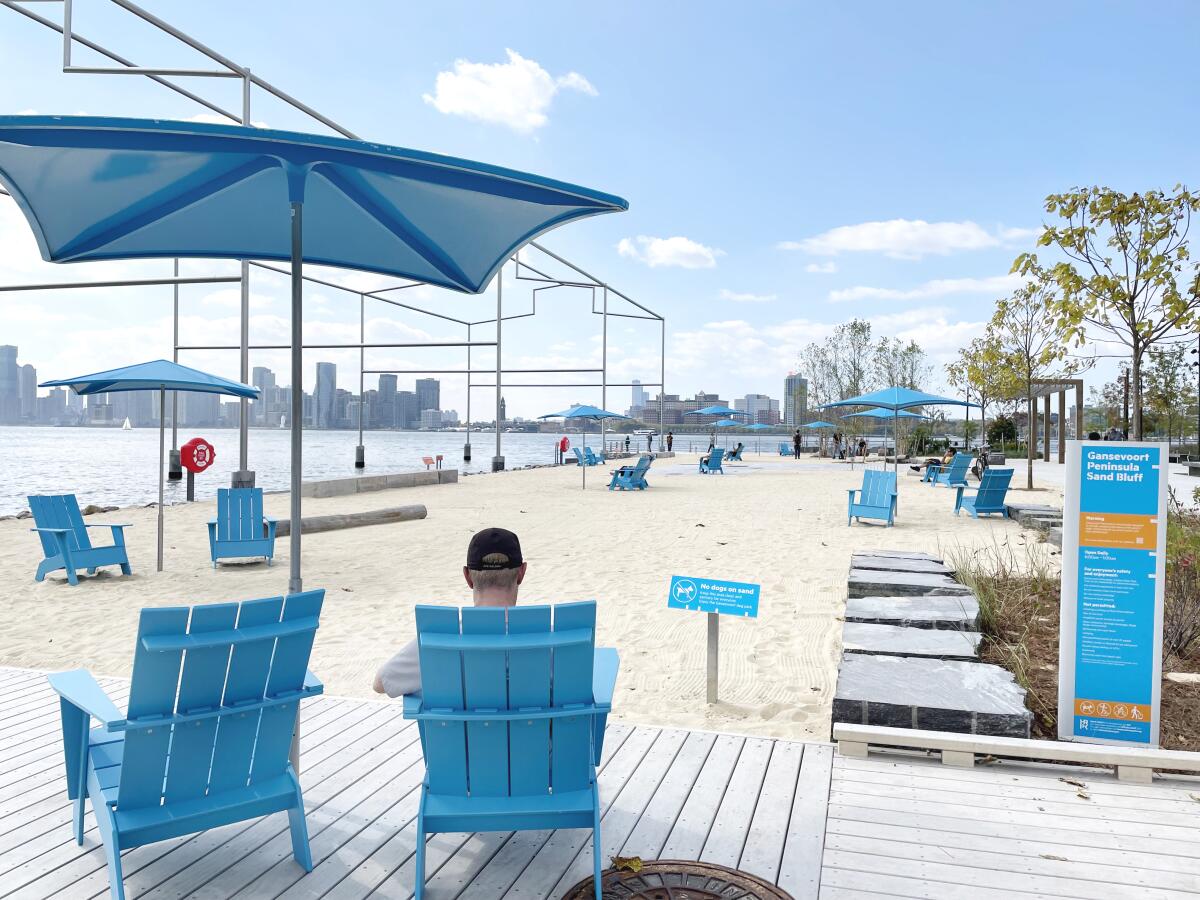
- Share via
NEW YORK — Dede Freeman and her daughter lounged in two blue Adirondack chairs on the beach under an umbrella as a copy of Nancy Allen’s “Renegade” blew open in the wind on the boardwalk nearby. Waves crashed against the tiered steps, children wearing coats built sandcastles, and one woman took off her Chelsea boots and dug her bare feet into the sand.
Freeman sat facing the skyline, each building rising up like children’s hands in a classroom. She sent a photo to her sister in Rancho Palos Verdes, who was puzzled by the sight.
“She’s like, ‘Where is a beach in Manhattan?’” said Freeman, who was in New York visiting her daughter, Erin.
The answer is on an old landfill, jutting out into the Hudson River.
Yes, a mere 2,800 miles away from the sun-drenched Manhattan Beach you know and love is an entirely different Manhattan beach, a first for this island smothered in asphalt, choked with skyscrapers and home to 1.6 million people.
The human-built world keeps getting in the way of the rising sea. But this current story of our coast does not have to end in disaster.
Gansevoort Peninsula, a 5.5-acre park between Gansevoort Street and Little West 12th Street in the Meatpacking District, opened last month. What was once a landfill is now home to a large sports field, an ecological salt marsh, a dog run, a boardwalk, manicured lawns and Manhattan’s first public beach.
OK, so the beach is more of an elevated sandy bluff. And there’s no swimming. Or parking. (Though there is a launching point for kayaks and canoes.)
“It’s not a California beach in the city, it’s not a Hamptons beach in the city, it’s not the Jersey Shore in the city,” said Noreen Doyle, president and chief executive of the Hudson River Park Trust, which oversees the park and its development. “It’s a really great sandy area.”
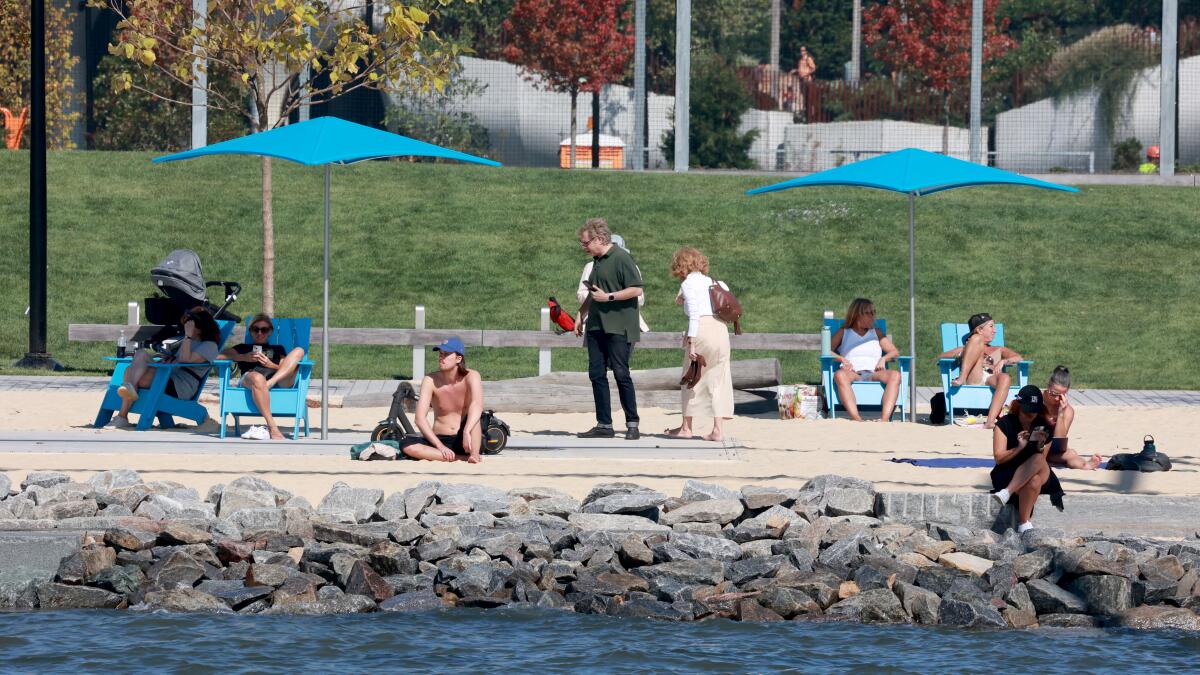
Decades ago, the western edge of Manhattan was a riverside strip of piers that had aged into retirement in a post-industrial New York. But a 1998 law helped create Hudson River Park, a constellation of public and green spaces four miles long — from Battery Park City to West 59th Street in Hell’s Kitchen — including dog runs, playgrounds, sports complexes, restaurants and entertainment venues connected by a manicured promenade.
The Gansevoort Peninsula presented a unique opportunity: It’s a landfill, not a pier supported by piles, as all the other structures are. “We could do things on that area differently,” Doyle said.
Like build a beach, which was part of the original vision for rehabilitating the area.
Field Operations, the firm behind Tongva Park in Santa Monica, spearheaded the project, which took about two years to complete and cost $73 million.
The site had to be demolished and cleared, and the New York City Department of Sanitation, the peninsula’s former tenant, had to relocate. Because the Hudson River is regulated, the U.S. Army Corps of Engineers and the New York State Department of Environmental Conservation were required to greenlight construction plans.
Losses are estimated at $15 billion in Acapulco, the storied Mexican beach town that had fallen on harder times even before Hurricane Otis struck.
Building the beach had its own challenges separate from building the overall park.
“When you think of the beach, you conjure up this notion of water touching sand, and being able to step off the sand directly into the water,” said Sanjukta Sen, who led Field Operations’ design and project team. “We quickly found that that’s not really a possibility.”
Some of the construction aspects for the beach were untested. The Hudson’s currents are strong, and ferries and other ships create even more turbulence. Designing a beach where the sand would hold required engineering.
The result is a 13,500-square-foot beach that’s “perched up,” Sen said. It’s not always touching water, but it still delivers beachy vibes, and the sand won’t regularly wash away.
New York, like many cities, is also experiencing more severe weather, with stronger winds and flash flooding, presenting another test for the human-made beach. Leading up to the peninsula’s inauguration, Tropical Storm Ophelia brought New York to a halt — but the beach was “bone dry” opening day, Sen said. (The site has interior drainage.)
“In some ways, this will be a bit of an ongoing experiment to see how this behaves in terms of the stress tests of different weather conditions,” Sen said. “We haven’t seen the full spectrum of it yet. It’s so new.”
Colorado River in Crisis is a series of stories, videos and podcasts in which Los Angeles Times journalists travel throughout the river’s watershed, from the headwaters in the Rocky Mountains to the river’s dry delta in Mexico.
Officials brought in 1,200 tons of sand — Doyle described it as “pristine, new, not-used-for-recreation-before-sand” — shipped in from a quarry in New Jersey. (One child with fistfuls of the stuff was unconvinced: “It’s not real!” she cried endlessly.)
Taking up just a part of the overall park, the beach was kept small, in part, to maintain the sensory ties to the river: sitting in the middle of a flat, 5.5-acre sandbox, “you wouldn’t see and hear the water,” the way the current design allows, Doyle said. There’s also the fact that New York real estate is precious, and New Yorkers have plenty of ideas of how spaces should be used.
Mateo Sancho said he was disappointed when he first saw how compact the beach was. But then stepping onto the sand, settling into a chair and catching up with an old friend — the “sensation is very different.”
“New York has been working on spaces that can feel like a day trip,” Sancho, 40, said. “This works in that sense.”
Grooming with heavy equipment prevents natural plants and dune formation on many coasts. Research in Santa Monica showed sand can rise faster than water if allowed to do so.
That same Friday that Dede Freeman had shocked her sister by texting her a photo of a beach in Manhattan — a beach in Manhattan! — Dan Hammerling, a longtime Florida transplant, took his friend Bob Ferruci, a lifelong New Yorker.
The octogenerians were on their way to lunch when Hammerling suggested they stop at the beach — “Bob didn’t believe me!” Hammerling joked.
Behind them was Little Island, a park at Pier 55 that Hammerling said resembles “concrete mushrooms” rising out of the Hudson River.
That, he said, is more unusual than a beach in Manhattan.
More to Read
Sign up for Essential California
The most important California stories and recommendations in your inbox every morning.
You may occasionally receive promotional content from the Los Angeles Times.
